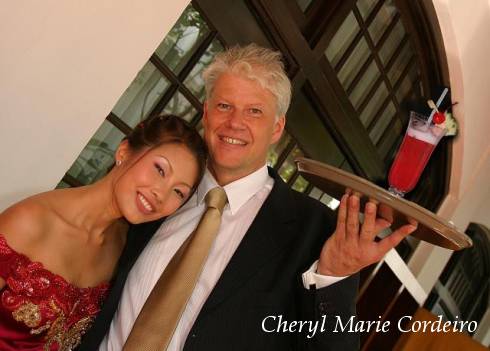
Singapore Sling, the romantic signature drink of the Long Bar, at Raffles Hotel in Singapore.
Photo © Steven Grindrod, JE Nilsson and Cheryl M. Cordeiro-Nilsson for CMC 2010
The Raffles Hotel was established in the Late 19th century and rapidly became a meeting place for the rich adventure seeking class of western men of leisure, British colonial officers and businessmen seeking fame and fortune in the Far East, and to whom “See you at Raffles!” became the signature parting words.
To the general public, Raffles Hotel became famous through literature. Those who could not afford to travel but stayed home, read and dreamt, were swept away by the romantic writings of the greatest authors of their time, the most influential of which was probably Somerset Maugham who actually lived at the hotel and wrote some of his stores in the Palm Court.
In 1987 its importance was recognized by the Singapore authorities by naming it a National Monument, not a small thing in a city where anything older than last year could suddenly be torn down and replaced by something more modern.
Although it started out as something much more modest, the ambience inside the Hotel brings back echoes of colonial splendour with its unique blend of tropical gardens and classical colonial grandeur.
Stories and myths build romance and there are many such surrounding the Raffles Hotel.
Many of Maughams short stories deal with the lives of mostly British colonists in the Far East, and are typically concerned with the emotional toll exacted on the colonists by their isolation. For example one story entitled “Rain”, which charts the moral disintegration of a missionary attempting to convert a Pacific Island prostitute. Maugham himself maintained that many of his stories presented themselves to him in what he heard during his travels, which made him leave behind a long string of angry former hosts. Which, is probably why he eventually found himself writing at a hotel, abuzz with even more rumours from all faraway outposts of the British Empire.
As its literary fame eventually faded away in a world dominated by digital social media, Raffles Hotel remains famous as the place where the Singapore Sling was invented by the bartender Ngiam Tong Boon sometimes during the first decades of the 20th century.
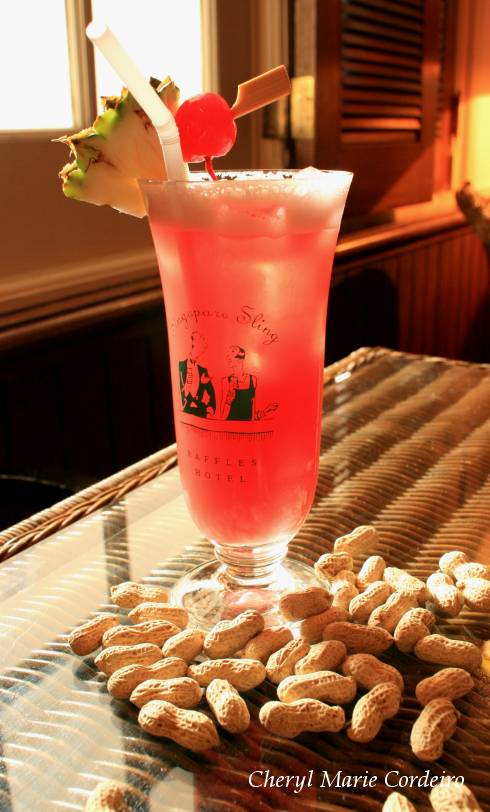
The Singapore sling was originally one cocktail among many similar gin based drinks of its time. It’s a mixture of gin and sweet liquor, tempered with a fruit juice. For one thing since its inception, gin has become infinitely much better than it once was.
The good part is that the taste of any drink at the Long Bar in some mysterious way is enhanced by the colonial ambience, and somehow all romantic notions the West has ever had of the East suddenly comes alive and adds a unique flavour to the drinks that just need to be experienced to be understood. However vague, this still to this day draws thousands of western tourists to the Long Bar making them pay a price for that drink that could easily have fed a whole family at some of the many other food outlets in the city, just outside the white walls of the Hotel.
But honestly, who cares. It’s maybe just once in a lifetime. The experience is even further enhanced by the crunching of the peanut peels freely served at the tables, and where the peel is actually intended to be thrown onto the floor. In this, you can basically see for yourself, the last tiger of Singapore walking through the premises, snarling at startled guests, to be finally shot to death under the pool table.
On the downside, I would say is that I think that the Singapore Sling in its signature glass with its signature colour (the hue of which changes from time to time), it is not really the same thing as it once was, invented one century ago, or maybe not even what it was just one decade ago, when I hesitantly enjoyed my first sip of this – face it – very silly drink.
I feel that what has happened to the Singapore Sling is probably the same as what has happened to many other legendary drinks, such at the fabled James Bond “stirred but not shaken” Martini as served at the Grand Casino in Monaco. The problem being that the true ingredients have changed or are just no longer available.
To the modern Singaporean, Raffles Hotel does not mean anything in particular. It’s small and a bit outdated. To most Singaporeans, Raffles Hotel is but another hotel, dwarfed by far more modern and magnificent structures in the heart of the city as the modern ION building at Orchard Road and the new Integrated Resorts of Sentosa and right next to the Singapore Flyer, the Bay-Sands.
As hotels go, the Fullerton Hotel, in similarly grand colonial style architecture and just a stone’s throw away from Raffles Hotel, is larger, and then there is St. Regis, a 6-star luxury hotel at the tip of Orchard Road, just a brief walking distance from the Singapore Botanic Gardens.
Still, however being much more “in” today, it is highly unlikely that any of these current state-of-art structures will be remembered one hundred years down the road, while it is quite likely that the Raffles Hotel will still offer its somber ambience and its signature Sling at the Long Bar. Romance never dies while a building, is just a building.
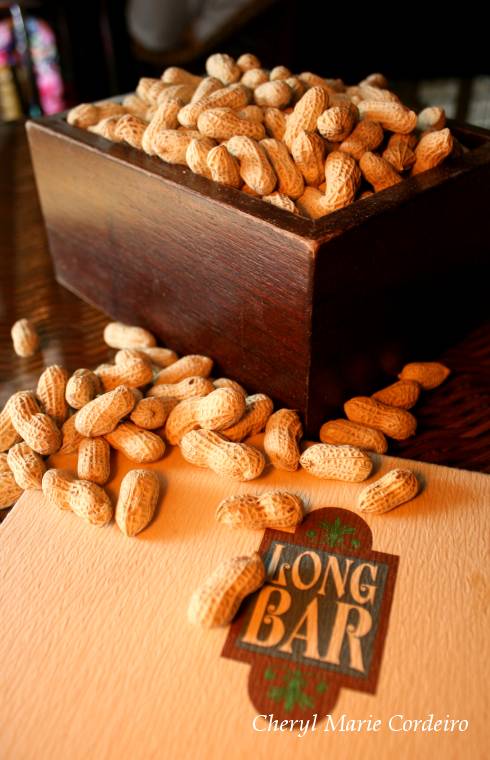
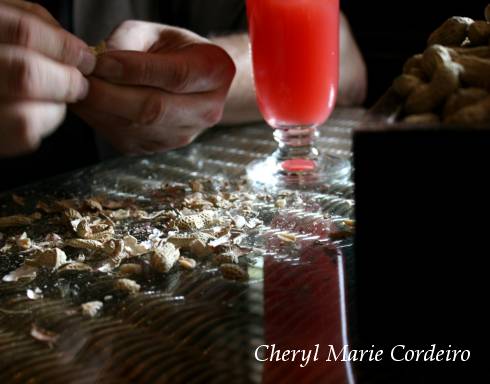
Peanuts and peanut cracking, a languid past-time at the Long Bar.
Just a few days ago I paid my regular visit to the Long Bar and the Hotel, since it carries some romantic importance in my life too. In the long bar was a large crowd of mostly Caucasian visitors sitting and enjoying in equal parts the silent air-conditioning, falsely credited to the originally hand held straw fans now swinging in the ceiling, the cracking sounds of peanut shells and the signature Singapore Slings.
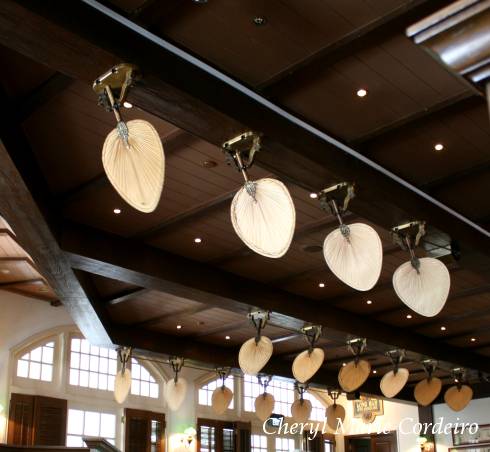
Once handheld for customers, these mechanized straw fans today line the ceiling of the Raffles Long Bar.
The dark rattan furniture and dark paneled window panes reminded me of the early 19th century Frankel Avenue single storey bungalows, sans air-con, that belonged to an old aunt of mine. Her house was full of light tan coloured rattan furniture with pretty tiffany glass lamps and those familiar hand held straw fans used to manage the sweltering heat that comes in from the sprawling garden. It’s a kind of house and feel that you seldom get to experience these days in Singapore with the built up HDBs and condominiums in Singapore.
As mentioned above, the exact recipe of the Singapore Sling has also long been lost as nobody seems to agree how to make this drink and just about every cocktail book I have consulted has a different recipe listed.
In preparation to my wedding and considering the extent of our combined knowledge of the South East Asian historical trade and culture, and with collaborative help from some Swedish and Singaporean culinary consultants’ knowledge about drinks and mixes, we set out to recreate a ‘most likely’ version of what this drink could have looked like as served in the 1910s.
For those interested in some experimentation I’ll post two recipes here, an original “Straits Sling” with dry cherry brandy (kirsch), and one possibly ‘official’, you see more often nowadays.
Straits Sling
2 dashes of Orange Bitters.
2 dashes of Angostura Bitters.
The juice of half a lemon.
1/8 gill (1/2 ounce) of Bénédictine.
1/8 gill (1/2 ounce) of Dry Cherry Brandy.
1/2 gill (2 ounces) of Gin.
Pour into a tumbler and fill up with cold soda water.
Singapore Sling (official)
3 ounces pineapple juice.
1-1/2 ounces gin.
1/4 ounce lime juice.
1/2 ounce Cherry Heering.
1/4 ounce Bénédictine.
1/4 ounce Cointreau.
1 dash Angostura bitters.
Shake with ice, strain. Top with a little soda water. Garnish with a flag (orange wedge and cherry on a pick).
While this latter is most probably very close to the tourist version served today at the Long Bar at Raffles Hotel in Singapore minus the orange wedge, our ambition here was to try to recreate the original version of the 1910s. You are most welcome to post the result and thoughts from your own experimentations.
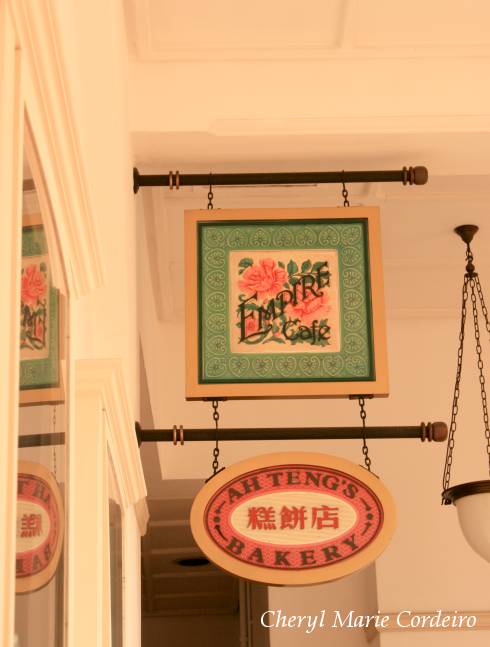
Staring through time – signboards of other eating places at the Raffles Hotel.
The places in Singapore where one can go to experience a sense and feel of our true history, is getting to be more and more rare. The Raffles Long Bar has a place to explain the early 19th century and I would recommend even Singaporeans to visit the Hotel from time to time, if and when the nostalgia for a time gone by hits you while the Singapore where we all grew up is getting more and more hidden under new layers of concrete and asphalt by and by.
2 thoughts on ““See you at Raffles!””